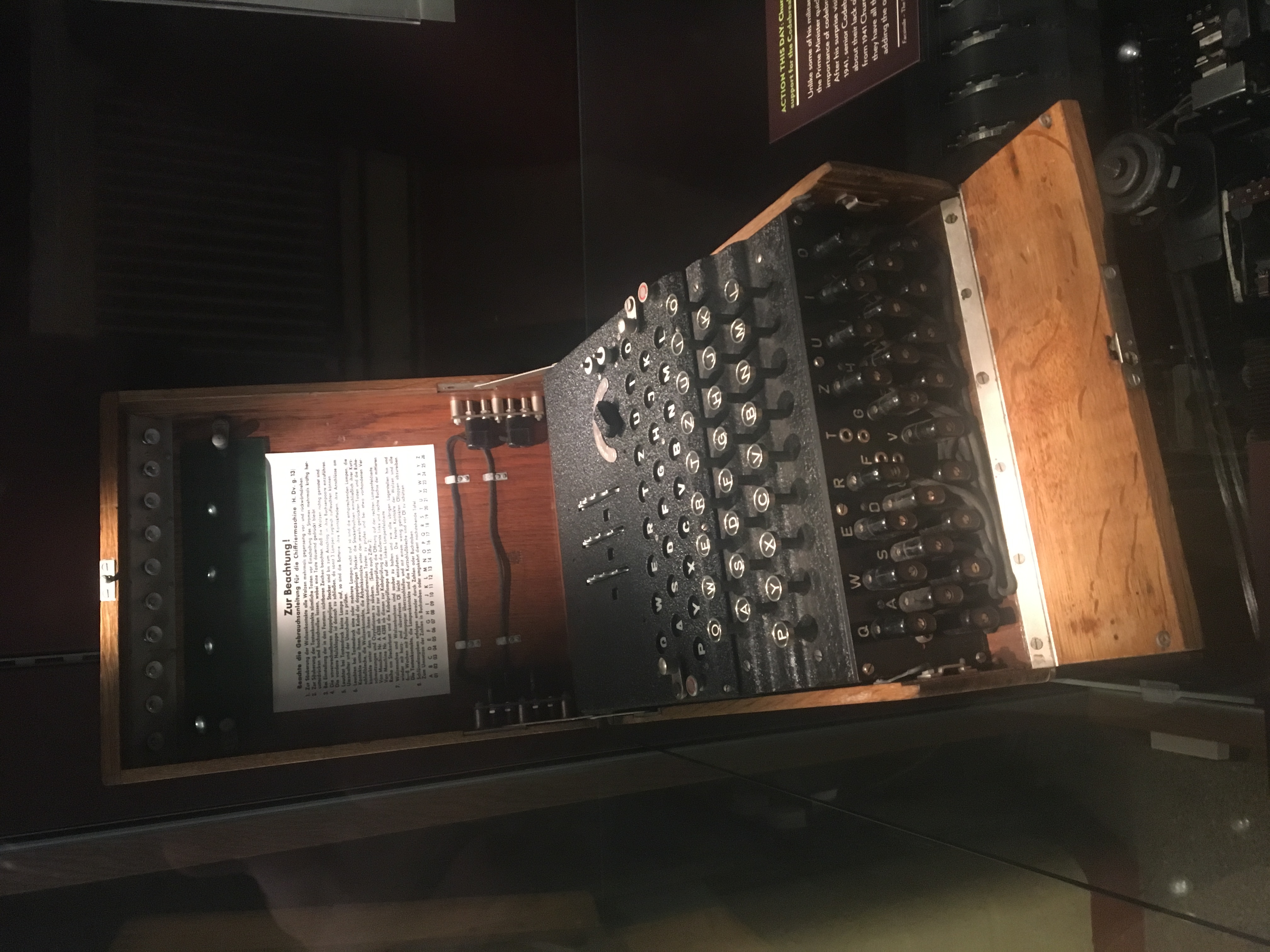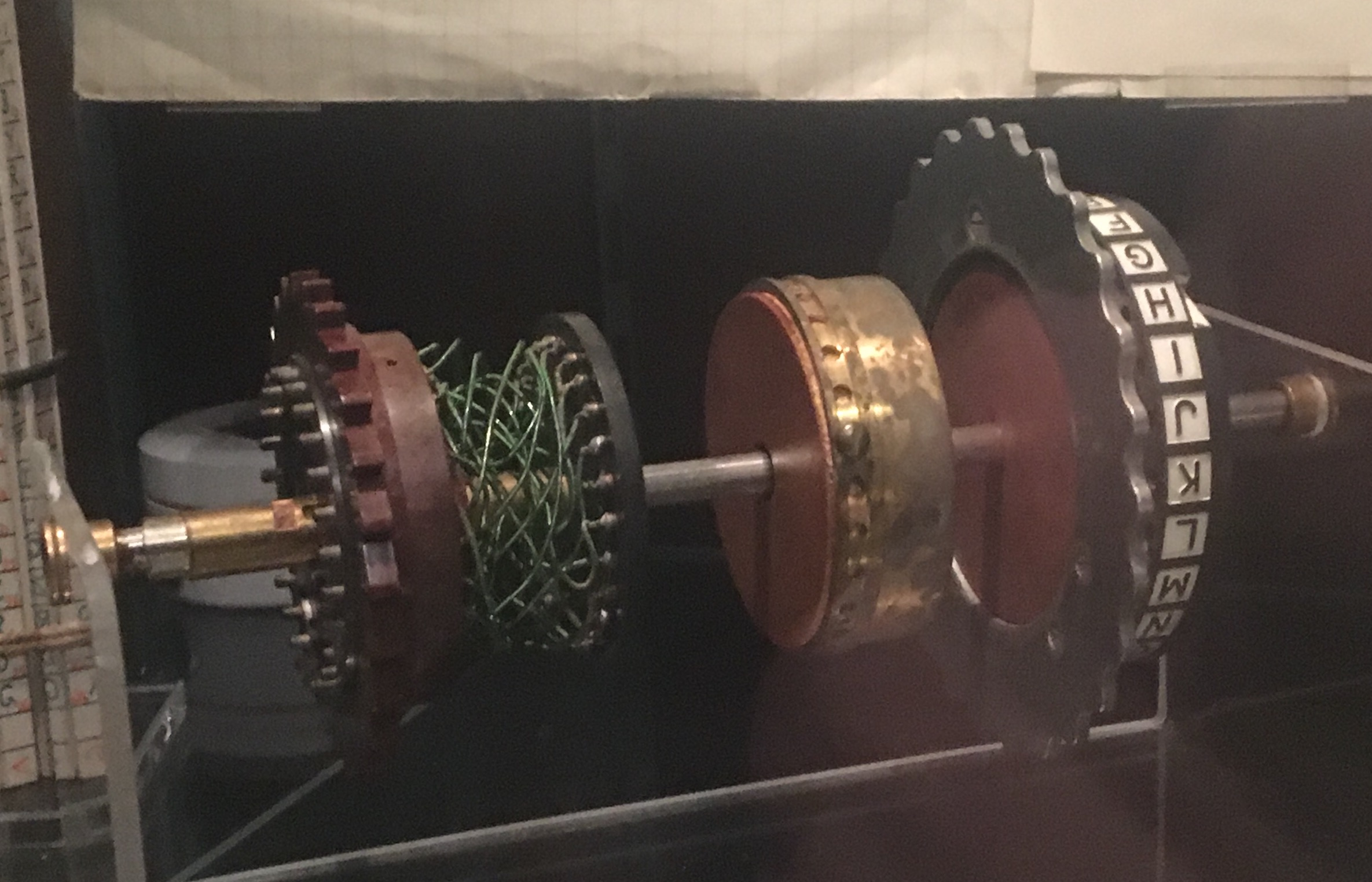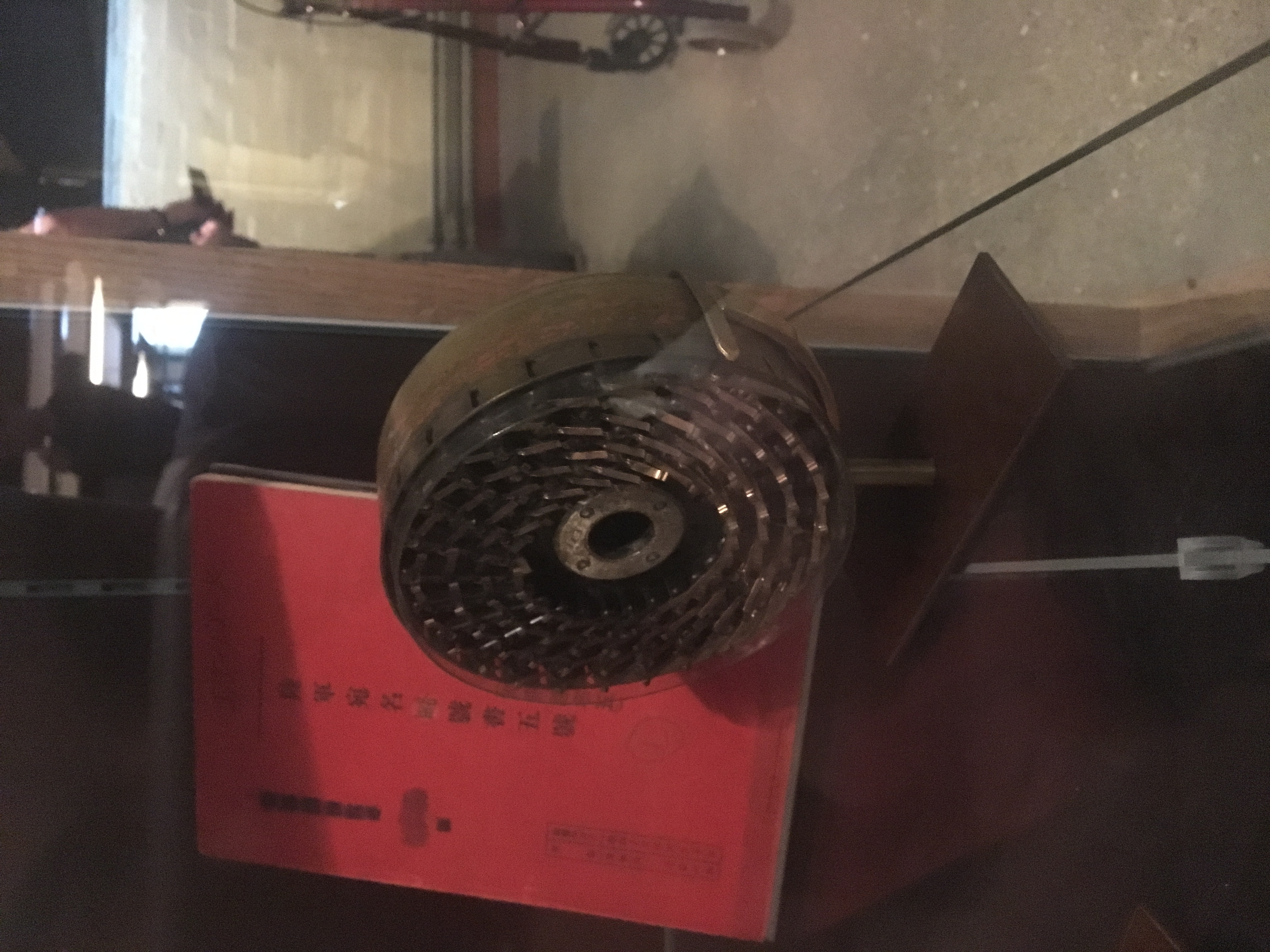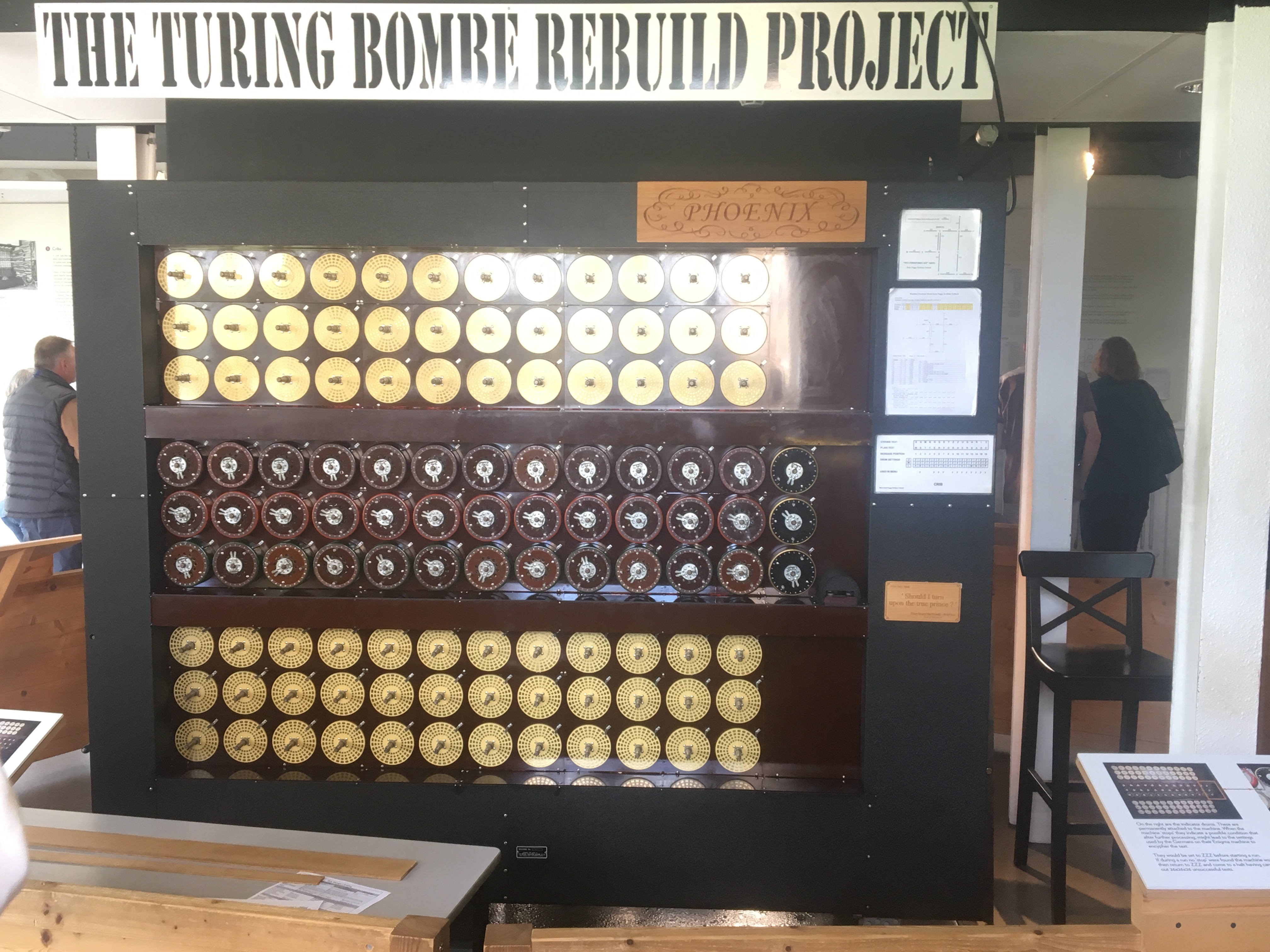British WW2 Codebreaking
From Londonhua WIKI
British WW2 Codebreaking
 3 Rotor Enigma Machine | |
| Location | Bletchly Park |
|---|---|
Contents
Abstract
The paragraph should give a three to five sentence abstract about your entire London HUA experience including 1) a summary of the aims of your project, 2) your prior experience with humanities and arts courses and disciplines, and 3) your major takeaways from the experience. This can and should be very similar to the paragraph you use to summarize this milestone on your Profile Page. It should contain your main Objective, so be sure to clearly state a one-sentence statement that summarizes your main objective for this milestone such as "a comparison of the text of Medieval English choral music to that of the Baroque" or it may be a question such as "to what extent did religion influence Christopher Wren's sense of design?"
Introduction
I suggest you save this section for last. Describe the essence of this project. Cover what the project is and who cares in the first two sentences. Then cover what others have done like it, how your project is different. Discuss the extent to which your strategy for completing this project was new to you, or an extension of previous HUA experiences.
As you continue to think about your project milestones, reread the "Goals" narrative on defining project milestones from the HU2900 syllabus. Remember: the idea is to have equip your milestone with a really solid background and then some sort of "thing that you do". You'll need to add in some narrative to describe why you did the "thing that you did", which you'd probably want to do anyway. You can make it easy for your advisors to give you a high grade by ensuring that your project milestone work reflects careful, considerate, and comprehensive thought and effort in terms of your background review, and insightful, cumulative, and methodical approaches toward the creative components of your project milestone deliverables.
Section 1: Background
Enigma
What is it and why was it a big deal
In order to communicate with troops on the battlefield and submarines away from base radio signals were utilized. This was a huge thing to do, but it did have it's drawbacks. As it was radio signals the enemy could intercept them. To protect the messages they needed to be enciphered. In the 1920s a German Engineer named Arthur Scherbius designed many different cipher machines. He settled on a design and called it Enigma.[1] This original design for Enigma was based upon a 26 letter keyboard for inputting the plaintext message, 26 lamps to show the cipher letters, a power supply, three removable wired wheels that rotate around a common axis, a fixed reflector, and a fixed entry wheel. How this was setup introduced two important features; no letter can encipher itself, and there is symmetry of plain-cipher pairs, ex. if J enciphers M, then M enciphers J.[2] This scrambling of letters would have been the equivalent of a complex substitution cipher if the wheels didn't move, but they did. Whenever a key was pressed a mechanical mechanism advanced the wheel one position, so after twenty-six key presses the first wheel would return to its starting position. Instead of being the same the second wheel would then turn, and once that wheel make it all the way around then the third wheel would turn. This rotating mechanism made the enciphering process very complex as all three wheels would not have returned to their original positions until 16,900 letters would have been enciphered.[3] This rotating motion made things difficult, but several other parts of the machine made things even more difficult. One of these was the option to take off the three wheels and reorder them in six different ways, this produced 101,400 different substitution alphabets. To add even more of a headache for anyone trying to decrypt the messages, the second rotor could be started in any one of its 26 positions which created 105,456 possible starting positions and substitution alphabets, and that's with having an Enigma machine which was the best case scenario.[4]
The German Military did not think this provided sufficient protection, so they made some changes to the design for their use. One major change that they introduced was the plugboard. The plugboard used up to thirteen short cables to switch letters at input and output of the machine. If, for example, B was connected to R, then whenever a B was pressed it would go into the rotors as an R, and vice versa. Also if an R came out of the rotors, the B light would turn on, and vice versa. This vastly increased the number of possibilities, as the plugboard settings have more than 10 million million possible settings, this made the total number of possible combinations rise to more than 10 million million million.[5] Another change made by the military was the addition of more rotors. They had five rotors that could be chosen and put in any order giving sixty possible combinations for the rotor order. [6] This increased the number of combinations even more, up to 150 million millionPUT IN ABOUT ADDING MORE ROTORS AND 4 ROTORS FOR NAVY
To set up an Enigma Machine[7]
1) The Operator would consult the list provided for the day's ground settings and turn the rotor's ring to those positions
2) The Operator would choose three random letters as the start position to encipher the message with
3) The Operator would then encode the start position twice
4) The Operator would turn the rotors to the start position and encode the message
5) The radio operator then would transmit the encoded message using Morse code
These changes made the number of possibilities unimaginable and theoretically unbreakable, but in use the Germans made several key mistakes.
Bletchley Park
What is Bletchley Park and what is special about it
Buildings
- Mansion - Additional information on the Mansion
- Hut 3 -
- Hut 6 -
- Hut 8 - Hut 8 was dedicated to the breaking of the German Naval Enigma Messages. It was here that Alan Turing lead his team in breaking the Naval Enigma codes.[8]
- Hut 11 - Hut 11 housed the Bombe Machines that were co-designed by Alan Turing and Gordon Welchman.[9] It was here that the WRENS, Women's Royal Naval Service, worked in teams of two to set up the machines according to the menus they were given to find possible settings for the day's Enigma settings.
- Hut 12 -
Alan Turing
Who is Alan Turing, what did he do, and how did he do it
Gordon Welchman
Who is Gordon Welchman, what did he do
Bombe
What is the Bombe, what does it do, who created it
In the multi-step process of breaking Enigma the Bombe was essential. All parts of the process are important but without the Bombe doing automated checking Enigma would have stayed unbreakable. The purpose of the Bombe was to utilize a crib, likely plain-text message, to check the 17,576 possible configurations of the rotors, which it did in about 10.5 minutes.[10] To set up a Bombe cryptographers created a menu which was formed from a plausible plain-text message. If the guess was correct the Bombe would stop giving the codebreakers a plausible starting position for the rotors and one of the plugboard connections.[11] To create a menu a crib was lined up with the cipher-text and as no letter can be enciphered as itself a plausible relationship between the two could be made. If X was the sixth position of plain-text and O was the sixth position of cipher-text then its possible that when the rotors had moved six places from the start X is enciphered as O.[12] This was done many times and created loops of letters enciphering each other. These loops when combined created a menu used to break enigma. The drums on the front of the Bombe turned around checking for the rotor positions but on the back of the machine were miles of wires connected between different letters to use these menus to remove false positives from the system.[13]
The Impact
The impact of the cracking Enigma, what it did for the British and the Allies, and the impact it has had on encryption
Section 2: Deliverable
Enigma Recreation
Virtual recreation of an enigma machine
The Math behind it
Math behind the Enigma machine and showing why it was such a difficult problem
Commercial
Army and Air Force
Naval
Gallery
Conclusion
In this section, provide a summary or recap of your work, as well as potential areas of further inquiry (for yourself, future students, or other researchers).
References
- ↑ Churchhouse, R. (2002). Codes and ciphers: Julius Caesar, the Enigma, and the Internet. Cambridge University Press. pp 111.
- ↑ Churchhouse, R. (2002). Codes and ciphers: Julius Caesar, the Enigma, and the Internet. Cambridge University Press. pp 112-115.
- ↑ Churchhouse, R. (2002). Codes and ciphers: Julius Caesar, the Enigma, and the Internet. Cambridge University Press. pp 119.
- ↑ Churchhouse, R. (2002). Codes and ciphers: Julius Caesar, the Enigma, and the Internet. Cambridge University Press. pp 119-120.
- ↑ Churchhouse, R. (2002). Codes and ciphers: Julius Caesar, the Enigma, and the Internet. Cambridge University Press. pp 119-120.
- ↑ Turing, D. (2014). Bletchley Park Demystifying the Bombe. pp 6.
- ↑ Churchhouse, R. (2002). Codes and ciphers: Julius Caesar, the Enigma, and the Internet. Cambridge University Press. pp 123.
- ↑ Hut 8. (n.d.). Retrieved May 25, 2017, from [1]
- ↑ Hut 11. (n.d.). Retrieved May 25, 2017, from [2]
- ↑ Turing, D. (2014). Bletchley Park Demystifying the Bombe. pp 10, 12.
- ↑ Turing, D. (2014). Bletchley Park Demystifying the Bombe. pp 11.
- ↑ Turing, D. (2014). Bletchley Park Demystifying the Bombe. pp 14.
- ↑ Turing, D. (2014). Bletchley Park Demystifying the Bombe. pp 23.


